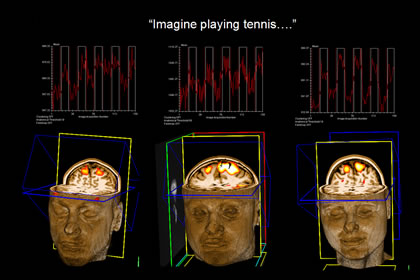The patient is a 23-year old woman, condemned to a vegetative state following a tragic automobile accident in 2005. Her sleep-waking cycles remain normal, but her eyes cannot focus or follow a person around the room.
Adrian Owen and his colleagues [1] conducted fMRIs of the patient and 12 healthy volunteers as they imagined themselves playing tennis or walking around their house. These instructions produce different patterns of brain activity that are easily distinguished by fMRI. Much to the team’s surprise, the patterns shown by the patient were quite similar to those of the healthy controls. Not only was she able to follow the directions, but her mind was capable of producing appropriate imagery.

Three healthy participants showed activity in the motor parts of the brain when asked to imagine themselves playing tennis. The patient’s scans were nearly identical.
What does this mean for people in a vegetative state? First of all, this is one patient, and much more research needs to happen before general conclusions about the vegetative state may be drawn.
Among the next steps the team would like to take are asking the patient a series of yes-no questions that might establish her level of conscious awareness.
The case raises obvious ethical dilemmas, especially when a patient in the vegetative state, such as Terry Schiavo, is removed from life support. If it is possible to establish some communication with such patients, their input on such a decision would be vital.
For more on the ethical implications of the case, check out the post on Brainethics.
[1] Owen, A. M., Coleman, M. R., Boly, M., Davis, M. H., Laureys, S., & Pickard, J. D. (2006). Detecting awareness in the vegetative state. Science, 313(5792), 1402.


1 Comment
emhughes · September 30, 2006 at 1:08 pm
I am glad to hear they are conducting research in this area. The brain is so powerful and I imagine there is a lot more going on in the brain of someone in a vegitative state than we ever imagined.
Comments are closed.